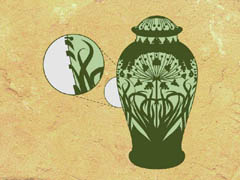
 The
Industrial Revolution came later to Sweden than it did to England.
The first land-based steam engine was installed in Sweden in 1807,
allowing pottery wheels that were driven by belts and powered by
steam engines to greatly increase the efficiency of ceramic production. The
Industrial Revolution came later to Sweden than it did to England.
The first land-based steam engine was installed in Sweden in 1807,
allowing pottery wheels that were driven by belts and powered by
steam engines to greatly increase the efficiency of ceramic production.Gustavsberg was one of only two manufacturers of porcelain in Sweden in the nineteenth century. In the eighteenth century, most porcelain goods were imported from China. By the end of the nineteenth century, however, Swedish factories were producing quality porcelains using varying amounts of a white clay called KAOLIN, the most essential ingredient. Although many pieces were made in molds, vases and
jars were thrown on a potter's wheel. To perfect the final shape,
the potter held a wood or porcelain mold against the inside of the
jar while following the outside with his other hand as it turned
on the wheel. Faults were smoothed out on a turning LATHE
after the piece was partially dry. When completely dry, it was polished,
placed in a SAGGER
(a protective clay box), and fired in a kiln. The temperature for
firing varied with the quality of the porcelain; the higher the
temperature, the greater the porcelain's strength. After the first
firing, the jar was GLAZED
according to the designer's plan, and then fired a second time.
Some designs were mass produced using stencils or templates. |
Key ideas.
Where does it come from?
What does it look like?
How was it used?
How was it made?
How big is it?
Who Knows?
Additional resources.
 Glaze
"recipes" were developed to produce consistent, specific
colors. The Gustavsberg factory became famous for the matte green
glaze and
Glaze
"recipes" were developed to produce consistent, specific
colors. The Gustavsberg factory became famous for the matte green
glaze and 